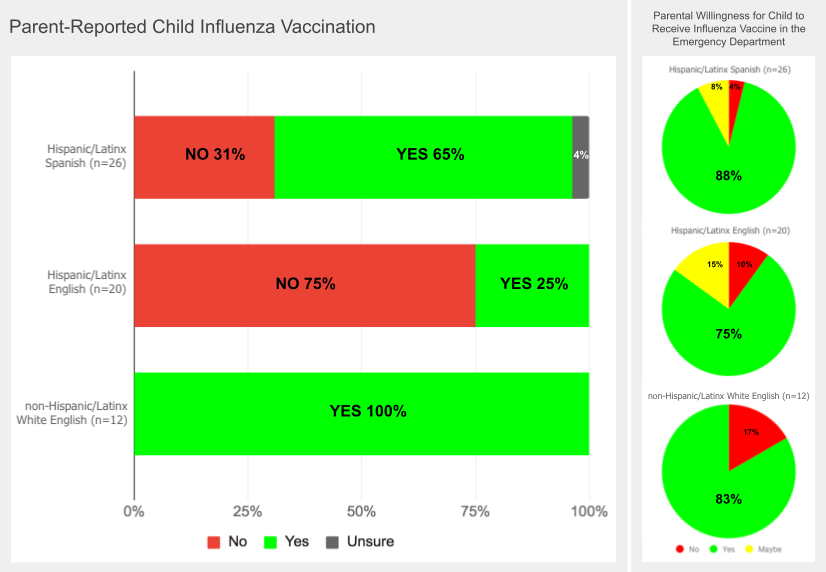Immunizations/Delivery
Category: Abstract Submission
Immunizations/Delivery II
512 - Attitudes about the Influenza Vaccine of Parents in the Pediatric Emergency Department
Sunday, April 24, 2022
3:30 PM - 6:00 PM US MT
Poster Number: 512
Publication Number: 512.326
Publication Number: 512.326
Jared Schiff, Children's Hospital Los Angeles, Los Angeles, CA, United States; Pradip P. Chaudhari, Children's Hospital Los Angeles, Los Angeles, CA, United States; Pia Pannaraj, Children's Hospital Los Angeles, Los Angeles, CA, United States; Danica B. Liberman, Children's Hospital Los Angeles, Los Angeles, CA, United States; Anita R. Schmidt, Children's Hospital Los Angeles, Los Angeles, CA, United States; Phung K. Pham, Children's Hospital Los Angeles, Los Angeles, CA, United States; Jocelyn B. Pérez, Children's Hospital Los Angeles, Moreno Valley, CA, United States

Jared Schiff, MD
Pediatric Emergency Fellow
Children's Hospital Los Angeles
Los Angeles, California, United States
Presenting Author(s)
Background: Though the influenza vaccine is recommended for children ≥6 months old, only 59% of Hispanic/Latinx children receive it. Sources of vaccine hesitancy have been identified through the World Health Organization’s 4C framework (calculation, complacency, confidence, convenience), but have not been thoroughly explored in the Hispanic/Latinx population.
Objective: We examined Hispanic/Latinx parents’ attitudes towards influenza vaccination and identified dimensions of vaccine hesitancy, as well as hypothetical parental willingness to have their child receive an influenza vaccine in the emergency department (ED).
Design/Methods: We conducted a multimethods study using quota sampling to gather qualitative and quantitative data from 3 groups of parents in the ED: Hispanic/Latinx Spanish speaking (HS), Hispanic/Latinx English speaking (HE), and non-Hispanic/Latinx White English speaking (WE). Parents engaged in a semi-structured interview and the Parent Attitudes about Childhood Vaccines (PACV) survey, where higher scores (0-100) indicate higher vaccine hesitancy. We extracted themes from the interviews using directed content analysis until saturation was achieved. We used descriptive statistics to summarize PACV data.
Results: From 58 sets of interviews and PACVs, we mapped parents’ perceived benefits and barriers of child influenza vaccination to the 4C themes (Figure 1). Both HS (n=26) and HE (n=20) parent groups, compared to WE parents (n=12), more often expressed community health promotion and beneficence as reasons to vaccinate, but also described healthcare inaccess as a barrier to vaccination. HS and HE parents had less knowledge about influenza and the vaccine, believed in myths about the vaccine, and were less likely to view influenza as a severe disease. PACV scores showed that, on average, WE parents were least vaccine-hesitant (M=15.1, SD=15.1), followed by HE parents (M=22.8, SD=22.1) and HS parents (M=24.6, SD=14.8). Although parental reports of influenza vaccine uptake were lower for Hispanic/Latinx children, the majority of parents in all 3 groups expressed willingness to have their child receive the influenza vaccine in the ED (Figure 2).Conclusion(s): We found that influenza vaccine hesitancy is greater among HS and HE parents, compared to WE parents. Further efforts to provide tailored education to the Hispanic/Latinx population should be explored. Parents’ hypothetical willingness to vaccinate their children against influenza in the ED indicates that the ED offers an additional setting to increase vaccination across different populations, and formal ED vaccine programs should be considered.
Curriculum VitaeCV JS.pdf
Parent-Reported Child Influenza Vaccination and Willingness for Child to Receive Vaccine in the ED Although parental reports of influenza vaccine uptake were lower for Hispanic/Latinx children, the majority of parents in all 3 groups expressed willingness to have their child receive the influenza vaccine in the ED.
Although parental reports of influenza vaccine uptake were lower for Hispanic/Latinx children, the majority of parents in all 3 groups expressed willingness to have their child receive the influenza vaccine in the ED.
Objective: We examined Hispanic/Latinx parents’ attitudes towards influenza vaccination and identified dimensions of vaccine hesitancy, as well as hypothetical parental willingness to have their child receive an influenza vaccine in the emergency department (ED).
Design/Methods: We conducted a multimethods study using quota sampling to gather qualitative and quantitative data from 3 groups of parents in the ED: Hispanic/Latinx Spanish speaking (HS), Hispanic/Latinx English speaking (HE), and non-Hispanic/Latinx White English speaking (WE). Parents engaged in a semi-structured interview and the Parent Attitudes about Childhood Vaccines (PACV) survey, where higher scores (0-100) indicate higher vaccine hesitancy. We extracted themes from the interviews using directed content analysis until saturation was achieved. We used descriptive statistics to summarize PACV data.
Results: From 58 sets of interviews and PACVs, we mapped parents’ perceived benefits and barriers of child influenza vaccination to the 4C themes (Figure 1). Both HS (n=26) and HE (n=20) parent groups, compared to WE parents (n=12), more often expressed community health promotion and beneficence as reasons to vaccinate, but also described healthcare inaccess as a barrier to vaccination. HS and HE parents had less knowledge about influenza and the vaccine, believed in myths about the vaccine, and were less likely to view influenza as a severe disease. PACV scores showed that, on average, WE parents were least vaccine-hesitant (M=15.1, SD=15.1), followed by HE parents (M=22.8, SD=22.1) and HS parents (M=24.6, SD=14.8). Although parental reports of influenza vaccine uptake were lower for Hispanic/Latinx children, the majority of parents in all 3 groups expressed willingness to have their child receive the influenza vaccine in the ED (Figure 2).Conclusion(s): We found that influenza vaccine hesitancy is greater among HS and HE parents, compared to WE parents. Further efforts to provide tailored education to the Hispanic/Latinx population should be explored. Parents’ hypothetical willingness to vaccinate their children against influenza in the ED indicates that the ED offers an additional setting to increase vaccination across different populations, and formal ED vaccine programs should be considered.
Curriculum VitaeCV JS.pdf
Parent-Reported Child Influenza Vaccination and Willingness for Child to Receive Vaccine in the ED
 Although parental reports of influenza vaccine uptake were lower for Hispanic/Latinx children, the majority of parents in all 3 groups expressed willingness to have their child receive the influenza vaccine in the ED.
Although parental reports of influenza vaccine uptake were lower for Hispanic/Latinx children, the majority of parents in all 3 groups expressed willingness to have their child receive the influenza vaccine in the ED.